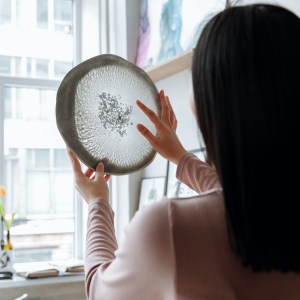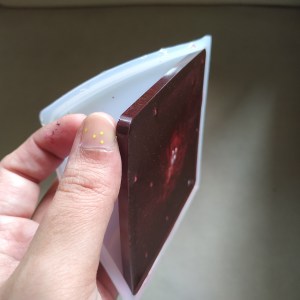Hello everyone! As promised, I am here, with complete details on working with this sticky, messy and crazy material called ‘Resin’. I will also share about creating designs with alcohol inks. I have clubbed these three styles because their methods are the same – random, uncontrolled, indisciplined and crazy.
It is because of this property that each piece of art is very different from the other. We create beautiful waves and ripples like flowing water resulting in abstract designs to make various usable objects.
Trays, Coasters, Keychains, Name Plates, Cookie stands, Cheese Boards, Wall Clocks, Wall Art, Bowls and Boxes to store little things, Jewellery, Stationery and more: there are so many things we can make with these art styles. We do not need any prior training in art for it. All three are popular activities for art-themed parties.




The material for these art styles is available in large quantities. I would say, “It is a good idea to share the material with a small group of people.” Everyone can take home a souvenir they made at the party. The colours can be mixed and provided in paper cups. The participants follow along instructions and everyone creates a beautiful and unique work of art. Imagine having fun and making art both at the same time.
Here is what you need and how to go about creating amazing works of art. The material is easily available at art stores and online. Some may feel the material is expensive as the minimum quantity is also large. It would be a good idea to use the material for other arts and crafts too. For a single project the material will turn out to be very expensive.
Fluid Art and Resin Art take about 24hrs to dry and set completely. Last but not least, if we spill the resin or the paint, it can get very messy. So unless you want a scolding from the house owner, please take adequate measures to cover your table or desk with newspapers or disposable mats or plastic sheets that will be discarded after the activity.
Fluid Art
Artwork created by pouring acrylic paint onto a surface is called Fluid Art. Acrylic paint with pouring consistency is readily available. All we need to do is pour the colours onto the surface. We pour multiple colours into a cup (one inside another) and then spill them on the canvas without mixing. A blower or dryer is used to blast hot air and create some special effects. It is a lot of paint. The excess paint drips from the surface. As the paint dries, it hardens.
An artist uses colour combinations to create designs of his taste and choice. The canvas must be kept horizontally on a levelled surface. We also get ready art kits for this kind of paint parties. Once the art is done, tap the canvas lightly at any corner to level out the paint and avoid lumps. The vibration created by tapping the canvas levels out the paint. Acrylic paint has its own shine. The last step is to spray varnish as a protective layer for your art.

You can clear coat it with resin to give a smooth glass like finish to the bumpy colours if you wish. It is like applying top coat to your nail art.
Alcohol Inks
Alcohol-based inks that have a nice deep colour are readily available in bottles. The bottle nozzle has a dropper. They are available in a wide range of colours. One thing we definitely need is an ‘alcohol blending solution’. Make sure you add that to your basket while shopping for alcohol-based inks.
The paper we use for this art is important. An impermeable surface works best. I used a thick textured watercolour paper. Sometimes, the ink can come on to the other side of the paper. It is not necessary to use paper. Other materials can also be used but they need to be primed or treated before use. Ceramic tiles can also be painted using this method. Clear coat the tiles with resin to give a glass like finish.

How to use them? Simply drop a few drops onto the surface and let them flow. The drops create ripples and flow in different directions. They never walk straight or as instructed. Jokingly I say the inks behave as if they are drunk and so they are called alcohol inks.
We can lift the paper and change the level of the paper to control the direction of the flowing ink. This helps avoid getting a large clump at a single spot. Alcohol Inks dry instantly. We use drops of the alcohol blending solution to blend the inks. Try both methods – first the ink drops and then the solution and vice versa. The results in both the case will be different but both are great ways to create art.
We get them in gold and silver too. Browse a few alcohol ink artworks online and notice a nice gold outline in the artwork. We can rub gilding flakes on the dry ink clump. It is tacky and the flakes easily stick to it. I really love stationery created with this method. It has a pop of colour, is simple and classy.

Resin Art
Resin is a kind of lacquer. It gives a nice reflective glass like finish. A clear coat is applied as a protective layer on various artefacts. I did a detail step-by-step post on clear coating your canvas in one of my earlier posts. As my hands were busy I could not share pictures. You may read the second half of the post on blue MDF coasters to know about clear coating using Resin.



The other method is using silicone moulds. Alcohol inks can also be added to the resin in order to create effects. Alcohol inks do not dissolve or blend completely in resin. Once a clear resin is poured into the mould, add a few drops of alcohol ink and see how it spreads in all directions like rays of the sun. I used a wooden toothpick in circular movements to create marble effect. Alcohol Inks have a certain amount of transparency when used with resin.

Beach scenes or seawater effects are the most trending works of Resin Art. We mix something called ‘Resin Pigment’ in the clear Resin to make opaque colours. We can add gilding flakes, sequins, dried flowers and leaves, acrylic cut lettering, glitter and other decorative things to the art. I just saw a few videos they used 3D liners and Washi Tape to create stain glass like effects. Bottles of crystals that look like crushed glass are readily available in various colours for Resin Art.

Art Resin is best for home use. It comes in two bottles. One will be the ‘Resin’ and the other will be the ‘Hardener’. Depending on the brand it is to be mixed in a paper cup in the proportion 1:1 or 2:1. Please read the instructions on the Resin bottles. The proportion is very important. In case it is not mixed in the correct proportion, it will not set correctly.

Stir the mixture continuously for 3mins until it becomes colourless. This is the clear Resin. Resin starts hardening after 30-40 minutes. So complete all the designing by then. Pigments are concentrated colours to be added and mixed with the resin using a wooden spoon or stick. They blend well with the Resin. Make a different colour in a different cup. Paper cups and wooden spoons work best for resin.








There is no method to pour these colours or mediums. We have to ‘go with the flow’. A heat gun is used to pop air bubbles that come up to the surface in the resin. I pop them using the pointed side of the toothpick. Resin is self-setting and must be left to dry on a levelled surface. Pour from the centre and it automatically spreads to the ends. Try different pours and see the results. It’s just fun!
I wanted Coasters for my table so I bought the square moulds. Moulds for all the objects are easily available at art and craft stores and online on Amazon and other marketplaces. If you want to make something else you can buy those moulds. The process is the same. It takes 12 hours to set and another 12 hrs for curing – a minimum of 24hrs are required before un moulding.
Professionally Resin is used with wood to make decorative furniture too. This requires further processing and is better to work in a studio. Resin gives out fumes that can be harmful if inhaled. They wear a mask while working. That is why for home use, we use a milder version – Art Resin. Children can work with resin if supervised by an adult. Once the resin hardens, it feels like an acrylic block.


Special Tip: A hairdryer or hot air blower helps push the colour in a particular direction or dry the ink before it spreads further. It also helps create special effects in Fluid Art – bubbles or fizzy kind of border. Use it to blow and lightly pop the bubbles in the resin. Now you see! It is such a handy tool while working with any of them. But be careful not to over do it or you will get blown away.
I made the Pink Coasters just to try the material. After that my Mom wanted me to make her a set of these wine and rose gold coasters. Abstract art is all about your aesthetic sense. It looks beautiful for any decor. Give these art styles a try for a fun-filled creative activity. Have an Arty Week!
View about clear coating with Resin in my previous post
